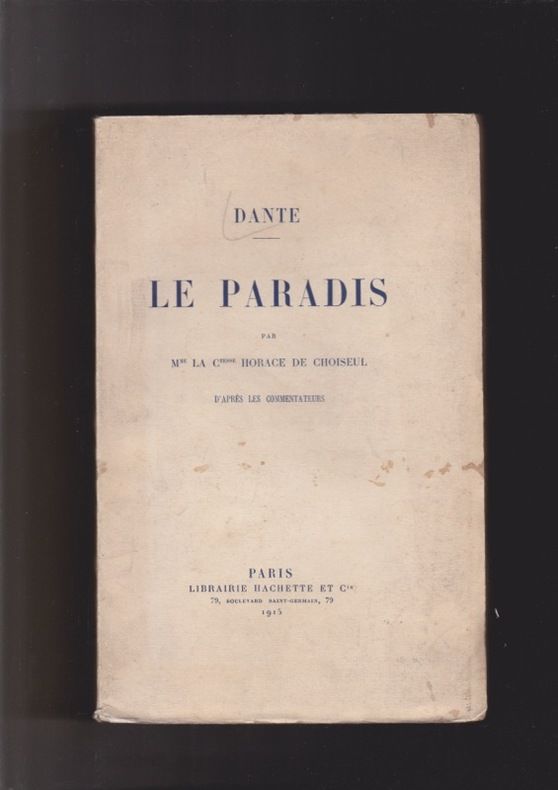John Hooper, former Excise Officer in Crediton:
A convicted criminal and self-styled surgeon whose son became a millionaire in Cincinnati, and whose granddaughter married into French aristocracy.
John Hooper was born in Bradninch, Devon, to farming parents in about 1785. His elder brother, William, became first a tanner and then a baker and grocer in St Sidwell’s in Exeter.
In 1811 John was working in Plymouth for “Widow Symons and Sons” as a merchant’s clerk, supervising loading and unloading at the docks. That year he married Sarah Harvie in Plymouth by licence. (Sarah Harvie’s application for marriage by licence was supported by James Scurry, at that time a grocer in Plymouth, whose reminiscences of his 10 years as a prisoner in India were later published.) Hooper later joined government service and was an excise officer for 18 years, working in Dorset, Reading, Crediton and latterly Barnstaple.
In 1818 Sarah Harvie’s younger brother Arthur emigrated to USA and settled in Cincinnati, Ohio, with his wife Maria (née Olver, also from Plymouth) and their two young sons. Arthur was one of the first settlers in that town, where he set up a distillery.
John Hooper had been working at Barnstaple for a couple of years when, on 22 September 1830, he was arrested and charged with theft from his colleague Edward Roberts Brook.
That evening Brook and his wife had gone to Barnstaple Fair. On their return at 9 p.m. they noticed a light inside their house. A man ran out of the back door, down Workhouse Lane where she grabbed hold of him. He escaped but was later apprehended in Potters Lane – and the man was John Hooper. The Brooks went back to their house and found that their savings of nearly £90 had gone. Close to where he was arrested the money was later found, as well as some implements including a pair of pincers and a chisel. He was committed for trial by Barnstaple’s Mayor and sent to Exeter gaol. It was said that he was a friend of Brook and that they had previously discussed what best to do with his savings.
It was not until March 1831 that his trial took place in Exeter at the Lent Assizes. Hooper was found guilty and sentenced to death, later commuted to transportation for life. His defence was that he was an innocent bystander who had joined in chasing the presumed burglar.
Many who knew him believed that his crime was out of character for someone who was seen as respectable.
A petition for clemency was signed by nearly 200 inhabitants of Barnstaple, Crediton and Exeter, including The Mayor of Barnstaple, the Sheriff of Devon; Stephen Hugo and HB Holman (two of Crediton’s surgeons), James Scurry and Jemima Harvie, Hooper’s sister-in-law.
John’s brother William Hooper and James Wentworth Buller of Downes, Crediton (M.P. for Exeter) wrote to Viscount Melbourne at the Home Office, asking that he should not be transported, for the sake of his family who were now destitute. It was suggested that he might be permitted to transport himself to USA, instead of being transported to the colonies, but this unusual suggestion was rejected.
In February 1832, William Luke Ponsford (an accountant in Exeter, brother of Luke Ponsford, surgeon) wrote to the other Exeter MP (Lewis W Buck) on behalf of his friend “Poor [William] Hooper the grocer of this Parish” whose brother John was on board the “Captivity” Hulk (in Devonport) about to be sent to Botany Bay. He predicts this would “break the poor fellow’s health” and refers to “almost incessant misfortunes that for some years past have affected his family” and that "his mind is almost distracted and ask him if it is possible to avert the intended transportation, and that if he was allowed in the future to banish himself to the interior of America, where the whole of his family are already gone".
Perhaps embarrassed by the crime, Sarah Hooper (57) and their two children, William (20) and Caroline (15) had already left England,sailing from London on 13th August 1831 on the “Samuel Robertson”, arriving in New York on 26 September. They made their way down to Sarah’s brother in Cincinnati.
In March 1834 William Hooper wrote to Buller: His "poor unfortunate brother" had been a convict on Captivity hulk in Plymouth for 3 years, working as assistant to the dispenser. The Plymouth Establishment was about to be broken up; he and family fear he will be sent abroad. Age 53. Surgeon Mr Williams can vouch for him. (Thomas Amphlett Williams 1809-1840.)
A couple of years later John was transferred to the Racoon Hospital ship off Gosport. John wrote to Lord John Russell, Secretary of State to Home department, asking for remission: he said he had been convicted on circumstantial evidence of a crime “revolting to my nature… transported for life, sent to a convict establishment at Plymouth, employed in the hospital as attendant on the sick under the direction of Mr Williams Chief Surgeon and have ever since performed those duties; the distressing scenes I have had to attend to day and night and the labours I have gone through during my confinement are well known to Mr Williams."
None of these petitions produced any results, however he never was transported.
In March 1839 he was pardoned and released.
By 1841 he had found his way to Burton on Trent where he was lodging with Philip Newton, also an excise officer, who was married to John’s niece Catherine.
The following February, 17 km away in Duffield Derbyshire, he married Elizabeth Waite, 35 years his junior. He was styled as a widower, and the son of William Hooper, surgeon, neither of which were true. Over the next six years they had a daughter, Mary, and two sons, John Henry and Alfred. All three of his children’s baptism records show their father’s occupation as surgeon.

[A second marriage was legally allowed when a spouse had been abroad for more than seven years.]
By 1857 he had established himself as the inn-keeper of the Royal Oak in Burton on Trent, where he lived until his death aged 77 in 1862. The younger of his new sons, Alfred, studied medicine, qualified MRCS in 1874 and proceeded MD Durham in 1904. When he married in 1876, he gave his late father’s occupation as surgeon.
In the USA John’s first family prospered. His wife Sarah lived with their son William, never remarried, and died in 1845. Their daughter Caroline never married and lived to be 84.
Son William quickly became a clerk in the Franklin Bank in Cincinnati. He later also ran a wholesale grocery business, but maintained his interest in banking, becoming president of the Central National Bank, and then director of The First National Bank when they amalgamated. During the civil war he was treasurer of the state of Ohio. A successful businessman, with his wealth he acquired a large amount of property.
He married firstly Annie Stetson Lee in 1854.They had a daughter who died the day she was born and Annie herself died in 1856. In 1863 he married a teacher, Mary Twombley née Neal. The widow of a Presbyterian minister, she had two young sons from her first marriage. In 1865 William and Mary Hooper had a daughter Mary.
In 1870 the Hooper family all went to France; Mrs Hooper and the three children remained in Paris: she was never to return to USA. William Hooper thereafter divided his time between Cincinnati and Paris, crossing the Atlantic more than 40 times in his lifetime. Young Mary was educated in a convent. William Twombley resided in Switzerland and France from 1881, married divorcée Marion Paine in Westminster in 1895 and remained in Europe “for the sake of my wife’s health” until his death in Montreux in 1928 and hers in 1936.

Mrs Hooper was not missed in Cincinnati.
Mary Hooper formed part of the social elite of Paris of that time. In January 1889, her 21 year old daughter married Italian Marquis Paolo Carlo Marie Theobald (Paul) d'Adda Salvaterra. They had a daughter, Marie-Louise the following June but Paolo died of pneumonia in December that year.
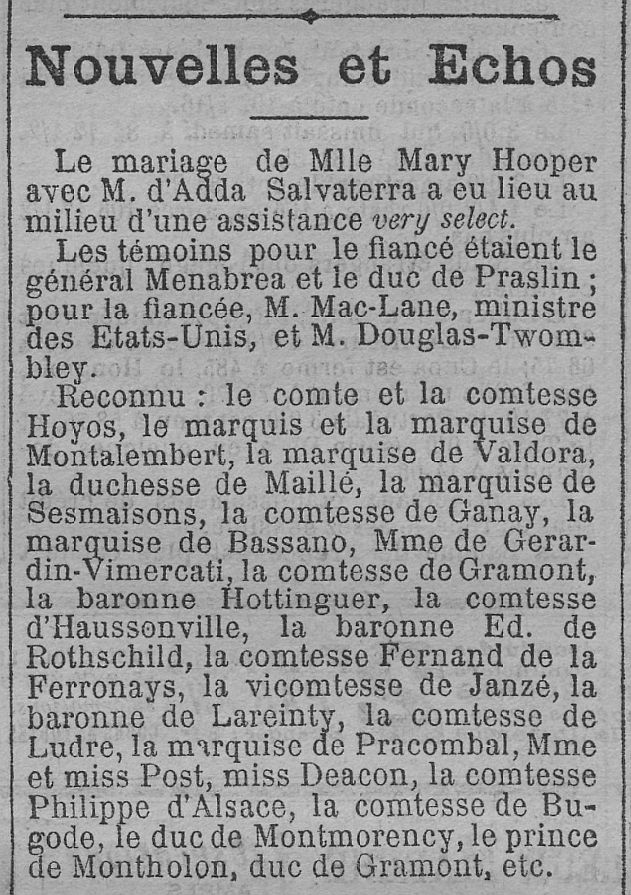
The widowed Marquise d’Adda Salvaterra returned to USA only twice – in 1894 when her father William Hooper became ill with Bright's Disease (kidney failure) and paralysis aged 83, arriving just a few days before he died; and in 1900 she brought her 11 year-old daughter to Cincinnati “to know the land of her ancestry”.
A few months before William Hooper died, he had transferred ownership of ¾ million dollars’ worth of real estate to his daughter. In his will which he wrote himself, large sums were left to various charitable institutions in Cincinnati, but as this was not valid these funds instead went to his wife in Paris. He shares a grave with his first wife and their baby, his mother and sister.
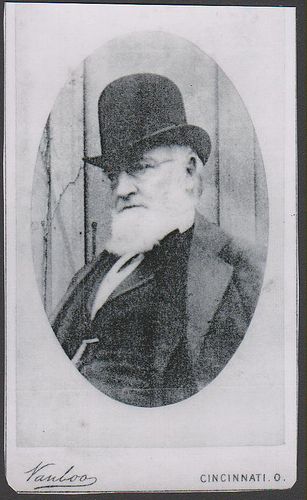

Above: William Hooper in his later years, and his mansion in Cincinnati, later owned by the Schmidlapp family
Below: The Hooper family grave in Spring Grove cemetery, Cincinnati
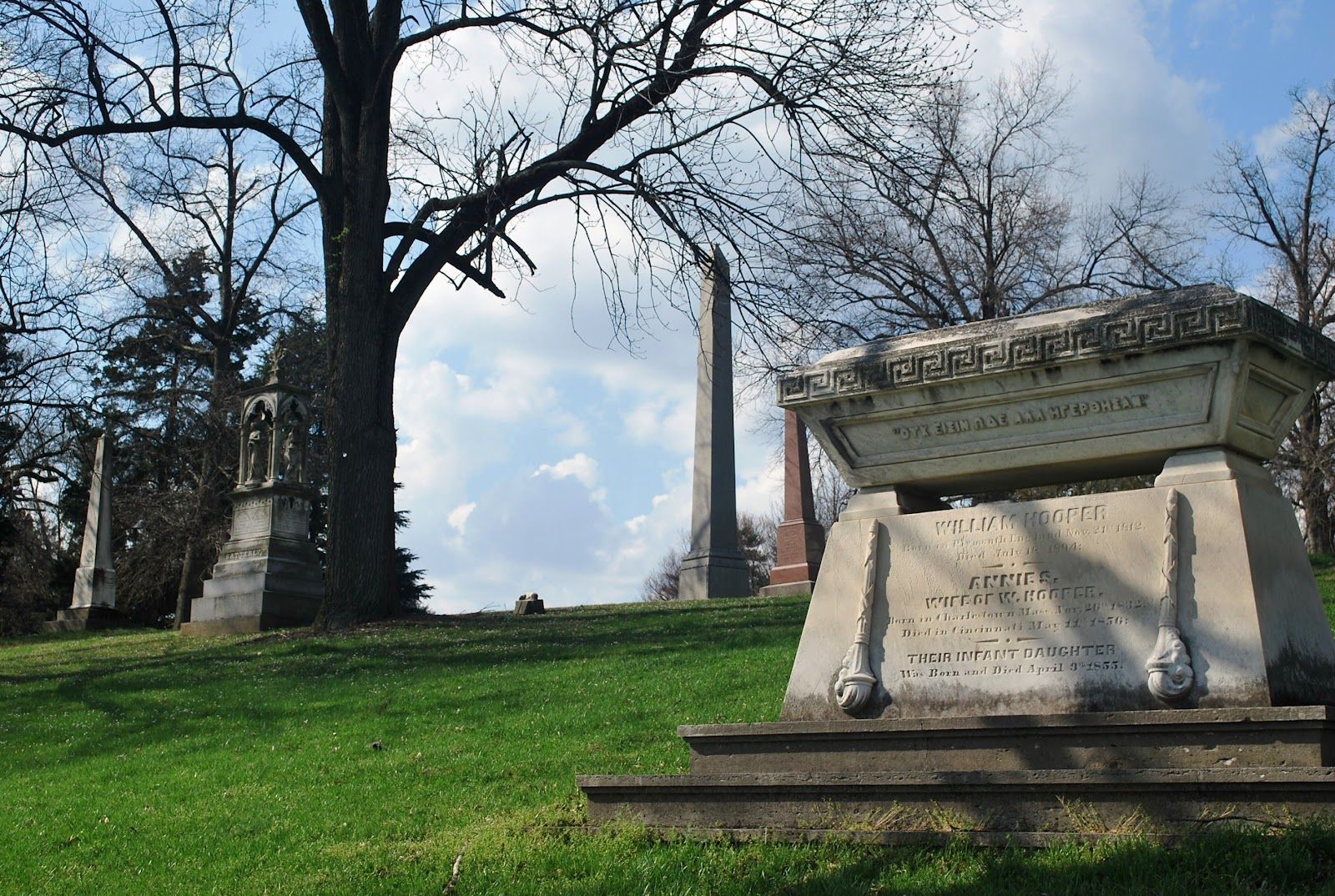
It was not until 1906 that Marquise Mary d’Adda Salvaterra, now 40, remarried, to her late husband’s uncle, Count Horace de Choiseul-Praslin who was 30 years older. His father (who was Mary's first husband's grandfather) Theobald had committed suicide while remanded in custody for murdering his wife in 1847.
Mary, now Countess of Choiseul, had a residence just outside Paris: the Pavillon Choiseul in Viry-Châtillon. (Viry-Châtillon was the site of “Port Aviation” - the first airport in the world which opened in 1909.)
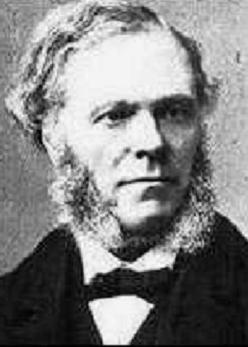

Comte Horace Eugène Antoine de Choiseul-Praslin (1837-1915) and Pavillon Choiseul in its heyday
Mary, the Countess of Choiseul lived at Pavillon Choiseul in Viry-Châtillon.
She established and worked at a dispensary for the villagers near her residence.
She also wrote two books about Dante.
The wealthy Countess of Choiseul (née Hooper) died aged 82 in 1948; her daughter Marie-Louise married Jaques Thomas de Pange and died in Viry-Châtillon in 1977 aged 88.
